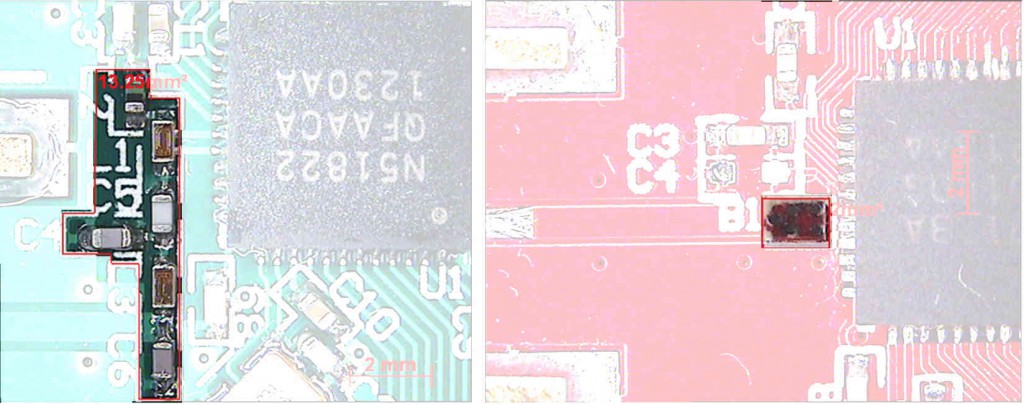2 mm2 instead of 13,25 mm2 space for your Bluetooth Low Energy or ANT+ balun
What does it mean? What will be the advantage? What will be the benefit?
The dark regions shows the space for the balun. The PCB surface on left picture is 13,25 mm2. On the right picture the PCB surface is 2 mm2 only.
| Feature | Advantage | Benefit |
| Just 2 mm2 space | 1 component instead of 6 | Less buying costs, costs for storage, pick and place and x-raying the PCB |
| Just 2 mm2 space | More space for proper ground plane | As bigger or as more homogeny the ground plane is as better the antenna can radiate and as better the range of the radio device will be |
| 1 component instead of 6 | Less risk to route components in PCB layout wrong | Saving money by saving redesign of PCBs |
| Just 2 mm2 space | Smaller design | Less costs for PCB and enclosure |
If you also want a small wireless design too, then just ask for by email to harald.naumann (at) gsm-modem.de

Are we comparing apples to apples here? The area on the left is not just a 2.4GHz radio chip (which, by itself, could be much smaller).
Hi Alex, you have to compare the two baluns. On left side there are 6 components in use. On the right side just one piece of hardware. Inside of the one chip are 6 components. This saves space and money. It minimise the risk to route PCB tracks wrong. I did not compare the ICs in this post. Nevertheless the IC is smaller than others as well. The IC already contain the DC/DC converter and it does not need a 16 MHz crystal. The saving of the DC/DC converter and the the crystal saves further space and money. It gives further space for a proper ground plane.
Hi Harold,
In response to Alexander, you have written the IC doesn’t need a 16 Mhz Crystal. How would a DC/DC Converter presence obviate the need for the crystal. Can you throw more light?
thanks,
venkat.
Venkat, if the DC/DC converter is already a part of the IC then this will save cost and money. If the crystal can be saves, then this will save PCB surface and money as well. If there is no need for external memory, then it will save further money and space. Read more here:
http://www.gsm-modem.de/M2M/m2m-faq/comparsion-of-bluetooth-low-energy-ble-bluetooth-smart-ics/
I made a comparison of two semiconductors this morning.
Hello, Not to get off topic of the ST Balun; however the nRFnRF51 series SOC shown in both the pictures does require a 16 MHz or 32 MHz external crystal in order to operate the radio portion of the device. There is an internal 16 MHz RC oscillator as well as an internal 32 KHz RC oscillator. There is also the option to use an external 32 KHz crystal if tighter timing is required. The DC/DC which is on the die is not required in order to use the device as there is an internal LDO but if used will extend the battery life considerably. The DC/DC takes two additional inductors and a cap. This is far better than having an external DC/DC converter which would add BOM cost and board space.
Oscillators, crystals and DC/DC converters I already mentioned this morning here: http://www.gsm-modem.de/M2M/m2m-faq/comparsion-of-bluetooth-low-energy-ble-bluetooth-smart-ics/
At the link you find a comparison with a IC from third party. This blog post shall just show, that it is possible to save PCB surface and money by selecting a balun carefully. Worst case other ICs does need an external memory as well.